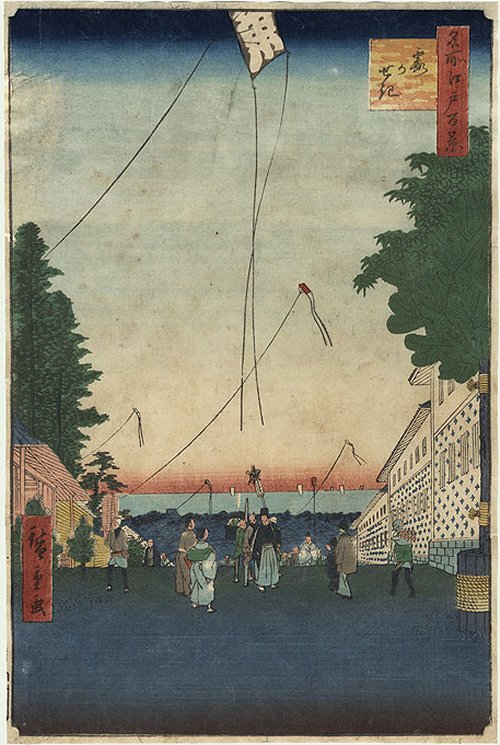| |
Hiroshige(1797 - 1858)Kasumigaseki |

"Kasumigaseki"
(霞かせき)
Series: One Hundred Famous Views of Edo
(Meisho Edo Hyakkei, 名所江戸百景 )
1857
Comment - Kasumigaseki (霞がせき) - Lovely
morning view of Street (today Kasumigaseki-zaka), on New Year.
The rooftops of Edo can be seen in the distance, with sails
dotting the ocean beyond. Celebrants make their way up the
slope and Edo-kites ("Edo-tako", "江戸凧") fly overhead. The
street is lined by the guardhouse of residence of Asano,
barracks of samurai of the Kuroda clan, leading directly to
Edo Bay. "Kadomatsu" gate pines and "manzai" dancers indicate
a setting around New Year. The large Edo kite on top of the
scene is painted with the Japanese character ("Kanji kite",
"ji tako", "字凧") for fish (Jap. "sakana", "魚"). This is a
reference to the publisher of the series, Sakanaya Eikichi, a
former fishmonger. Beautiful view from Hiroshige's "100 Famous
Views of Edo", with a decent bokashi shading.
"Bokashi" (Japanese: ぼかし) is a technique used in Japanese woodblock printmaking. It achieves a variation in lightness and darkness (value) of a single color by hand applying a gradation of ink to a moistened wooden printing block, rather than inking the block uniformly. This hand-application had to be repeated for each sheet of paper that was printed. This obviously may lead to variation in prints. The best-known examples of bokashi are in the 19th-century ukiyo-e works of HIROSHIGE (se above) and HOKUSAI, in which the fading of Prussian blue dyes in skies and water create an illusion of depth.
In 1856, Hiroshige began designing what was to be his last great series and a masterpiece "100 Famous Views of Edo". Each print from this series was a classic Hiroshige landscape work, taking advantage of the vertical format to capture a slice of life from Edo in dramatic and interesting ways. The series was very popular with the public and new releases were eagerly anticipated over the time that Hiroshige released the designs. The prints were first published in serialized form in 1856–59 see above), with his pupil "HIROSHIGE II" completing the series after Hiroshige's death.
The horizontal ('landscape') version of the above Kasumigaseki woodprint, with a similar scene at the same location and with kites, but from the different series "Famous Places of the Eastern Capital" (江都名所 Kôto Meisho), is named "View of Kasumigaseki".
"Kasumigaseki" is one of the classical examples of Japanese woodblocks. You may find it as an representative of Japanese art in general, on the following stamp (sheet) Dominica 1997, or refer to my book on "Kite Stamps of the World).
Series - The print is the Number 2 of the series "One Hundred Famous Views of Edo" (名所江戸百景 Meisho Edo Hyakkei). Two other woodblocks from the same series, containing kites are "Hibiya and Soto-Sakurada from Yamashita-cho" and "Mount Atago in Shiba". For information about other Series of Hiroshige, refer to HIROSHIGE's "Tokaido" and other Series.
Artist - see Biography
Signature - Hiroshige ga (広重画) (lower left, red cassette)
Publisher - Uoya Eikichi (魚屋 栄吉) <Sakana Sakae, 魚栄>; lower left, partially cut
Image Size - 21.9 cm X 34.5 cm (8 3/4" x 13 3/8")
Condition - single sheet; nishiki-e (cloured woodblock); Vertical ôban; Tate-e (portrait)
"Bokashi" (Japanese: ぼかし) is a technique used in Japanese woodblock printmaking. It achieves a variation in lightness and darkness (value) of a single color by hand applying a gradation of ink to a moistened wooden printing block, rather than inking the block uniformly. This hand-application had to be repeated for each sheet of paper that was printed. This obviously may lead to variation in prints. The best-known examples of bokashi are in the 19th-century ukiyo-e works of HIROSHIGE (se above) and HOKUSAI, in which the fading of Prussian blue dyes in skies and water create an illusion of depth.
In 1856, Hiroshige began designing what was to be his last great series and a masterpiece "100 Famous Views of Edo". Each print from this series was a classic Hiroshige landscape work, taking advantage of the vertical format to capture a slice of life from Edo in dramatic and interesting ways. The series was very popular with the public and new releases were eagerly anticipated over the time that Hiroshige released the designs. The prints were first published in serialized form in 1856–59 see above), with his pupil "HIROSHIGE II" completing the series after Hiroshige's death.
The horizontal ('landscape') version of the above Kasumigaseki woodprint, with a similar scene at the same location and with kites, but from the different series "Famous Places of the Eastern Capital" (江都名所 Kôto Meisho), is named "View of Kasumigaseki".
"Kasumigaseki" is one of the classical examples of Japanese woodblocks. You may find it as an representative of Japanese art in general, on the following stamp (sheet) Dominica 1997, or refer to my book on "Kite Stamps of the World).
Series - The print is the Number 2 of the series "One Hundred Famous Views of Edo" (名所江戸百景 Meisho Edo Hyakkei). Two other woodblocks from the same series, containing kites are "Hibiya and Soto-Sakurada from Yamashita-cho" and "Mount Atago in Shiba". For information about other Series of Hiroshige, refer to HIROSHIGE's "Tokaido" and other Series.
Artist - see Biography
Signature - Hiroshige ga (広重画) (lower left, red cassette)
Publisher - Uoya Eikichi (魚屋 栄吉) <Sakana Sakae, 魚栄>; lower left, partially cut
Image Size - 21.9 cm X 34.5 cm (8 3/4" x 13 3/8")
Condition - single sheet; nishiki-e (cloured woodblock); Vertical ôban; Tate-e (portrait)
Copyright 2008 ff: Hans P. Boehme